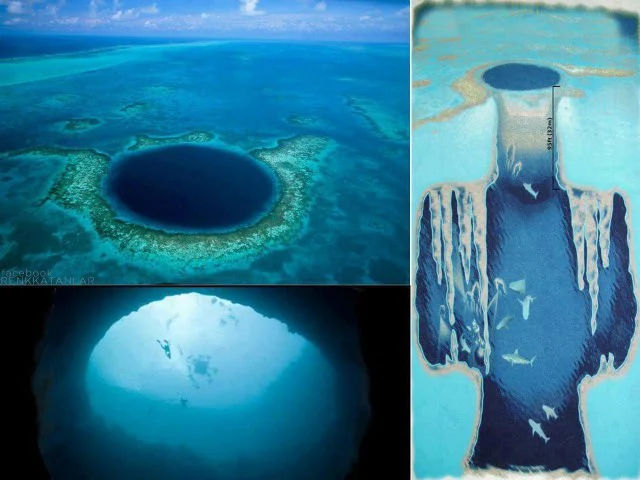The Great Blue Hole is off the coast of Belize. It lies near the center of Lighthouse Reef, a small atoll 70 km (43 mi) from the mainland and Belize City. The hole is circular in shape, 318 m (1,043 ft) across and 124 m (407 ft) deep. It was formed during several episodes of Quaternary glaciation when sea levels were much lower. Analysis of stalactites found in the Great Blue Hole shows that formation took place 153,000; 66,000; 60,000; and 15,000 years ago. As the ocean began to rise again, the cave was flooded. The Great Blue Hole is a part of the larger Belize Barrier Reef Reserve System, a World Heritage Site of the United Nations Educational, Scientific and Cultural Organization (UNESCO).
Initial measured depth of Great Blue Hole was 125 m (410 ft) which is the most often cited depth up to this day. An expedition by the Cambrian Foundation in 1997 measured the hole's depth as 124 m (407 ft) at its deepest point. This difference in measurement can be explained by ongoing sedimentation or by imprecision in measurements. The purpose of this expedition was the collection of core samples from the floor of the Blue Hole and documentation of the cave system.To accomplish these tasks, all of the divers had to be certified in cave diving and mixed gases.
This site was made famous by Jacques Cousteau, who declared it one of the top five scuba diving sites in the world. In 1971 he brought his ship, the Calypso, to the hole to chart its depths.Investigations by this expedition confirmed the hole's origin as typical karts limestone formations, formed before rises in sea level in at least four stages, leaving ledges at depths of 21 m (69 ft), 49 m (161 ft), and 91 m (299 ft). Stalactites were retrieved from submerged caves, confirming their previous formation above sea level. Some of these stalactites were also off-vertical by 5˚ in a consistent orientation, indicating that there had also been some past geological shift and tilting of the underlying plateau, followed by a long period in the current plane. The tilt indicates that this was a movement of the land, rather than a rise in sea level alone.
Initial measured depth of Great Blue Hole was 125 m (410 ft) which is the most often cited depth up to this day. An expedition by the Cambrian Foundation in 1997 measured the hole's depth as 124 m (407 ft) at its deepest point. This difference in measurement can be explained by ongoing sedimentation or by imprecision in measurements. The expedition's goal was to collect core samples from the Blue Hole's floor and document the cave system. To accomplish these tasks, all of the divers had to be certified in cave diving and mixed gases.
The name "The Great Blue Hole" was coined by British diver and author Ned Middleton in the book "Ten Years Underwater".
This is a popular spot among recreational scuba divers who are lured by the opportunity to dive in sometimes crystal-clear water and meet several species of fish, including Midnight Parrotfish, Caribbean reef shark, and other juvenile fish species. Other species of sharks, such as the bull shark and hammerheads, have been reported there, but are not regularly sighted. Usually, day trips to the Great Blue Hole are full-day trips from the coastal tourist communities in Belize.
On-shore caves of similar formation, as large collapsed sinkholes, are well known in Belize and in the Yucatán Peninsula, where they are known as cenotes. Unlike the mainland cenotes which often link to underwater cave systems, there is little evidence of horizontal development in the Blue Hole.
In 2012 Discovery Channel ranked the Great Blue Hole as number one on its list of "The 10 Most Amazing Places on Earth".
Even though the Great Blue Hole is considered a bucket-list dive, one should be aware that it is not for divers of all skill levels – a prerequisite is logging more than 24 dives. It is also not a 'colorful dive', instead, divers witness a dark cave with impressive stalactites. The Great Blue Hole has also been the site of infrequent skydives. Both tandems and fun jumpers have landed in the ocean after rides from 12,000 feet.





No comments:
Post a Comment
Stay updated with our blog for more quality content! Your feedback is appreciated. Contact us at harshrex@outlook.com with any suggestions.